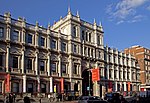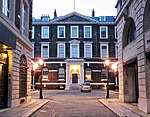Contemporary Indian Art
Contemporary Indian Art was an exhibition held from September 18 – October 31, 1982 at The Royal Academy of Arts in London. The exhibition featured two sections, I. The Gesture, and Motif, which was on view from September 18 – October 5, 1982, and II. Stories, Situations, which was on view from October 9 – 31, 1982. The exhibition was co-curated by Akbar Padamsee, Richard Bartholomew, and Geeta Kapur.The exhibition was part of the ''Festival of India,'' a six-month showcase for Indian culture and art co-sponsored by the governments of the United Kingdom and India. Prime Minister Indira Gandhi remarked at the opening, ''The links between our two peoples have always been unique. That is why this artistic celebration means so much to us, and to them.''
Excerpt from the Wikipedia article Contemporary Indian Art (License: CC BY-SA 3.0, Authors).Contemporary Indian Art
Piccadilly, City of Westminster Mayfair
Geographical coordinates (GPS) Address Phone number Website Nearby Places Show on map
Geographical coordinates (GPS)
| Latitude | Longitude |
|---|---|
| N 51.509166666667 ° | E -0.13944444444444 ° |
Address
Royal Academy of Arts (RA)
Piccadilly
W1J 0BD City of Westminster, Mayfair
England, United Kingdom
Open on Google Maps











